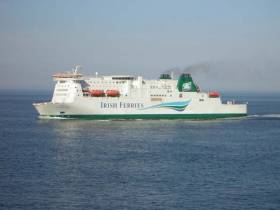Displaying items by tag: Wales
Pwllheli Lifeboat Station Closes Over ‘Disharmony’ Between Crew Members
Pwllheli RNLI has closed over “ongoing distrust and disharmony” between crew members at the North Wales lifeboat station.
According to BBC News, a number of key personnel have also resigned from the station, prompting the RNLI to “reset operations”.
“Until we’ve got a safe number of crew and a safe management structure to support that lifeboat station, we’re not able to go back on to service,” said the RNLI’s Wales manager Ryan Jennings.
A statement from the RNLI said its decision to close the Pwllheli station was “not taken lightly but is considered necessary to move forward with an inclusive and sustainable lifeboat station…for many years to come”.
Pwllheli is a regular haunt for Irish sailors taking part in the annual ISORA races.
BBC News has more on the story HERE.
Atlantic Bluefin Tuna Hooked Off Pembrokeshire Coast Believed to Be Biggest Ever Caught in Welsh Waters
An Atlantic bluefin tuna hooked off the Pembrokeshire coast recently is believed to be the biggest fish ever caught in Welsh waters.
As Wales Online reports, the 900lb (408kg) monster catch was made by Simon Batey and Jason Nott while returning from an angling trip in the Irish Sea.
Keeping the tuna in the water, they recorded a measurement of 111 inches (2.82 metres) from nose to tail before releasing it back into the sea.
The anglers were on a boat from White Water Charters which is licensed to catch, tag and release Atlantic bluefin tuna as part of a Welsh government programme similar to the Tuna CHART scheme in Ireland.
Wales Online has more on the story HERE.
A woman has been arrested after the death of a fourth person following a paddleboarding tragedy in South Wales last weekend.
As Wales Online reports, three people died at the scene after an incident on the morning of Saturday 30 October on the Cleddau River in Haverfordwest — north of Pembroke and just 100km across St George’s Channel from Rosslare.
The three were later named Nicola Wheatley (40), Morgan Rogers (24) and Paul O’Dwyer (42). O’Dwyer is said to have died while attempting to rescue the others.
A fourth person, Andrea Powell (41), was recovered from the scene in critical condition but Dyfed-Powys Police confirmed this morning (Saturday 6 November) that she had died in hospital.
In the same statement, the police also confirmed that they has arrested a woman from the South Wales area “on suspicion of gross negligence manslaughter as part of the investigation. She has been released under investigation.”
Wales Online has more on the story HERE.
Ports in Wales Under threat from Post-Brexit Trade
Ferry ports in Wales is where the nation's government has warned that post-Brexit trading patterns threaten the viability of the country's Irish Sea ports.
Trade flows from Ireland to Welsh ports have collapsed since January.
Irish hauliers are avoiding the ports due to complicated new administration.
The Welsh government has published a plan aimed at simplifying those processes and encouraging the return of Irish freight.
It says: "The urgency of this work has become self-evident.
"Data for Welsh ferry ports volumes in February shows a relative decline of in 'year-to-date volumes' of 50% in Holyhead, and 40% in the south West."
Brexit and the Irish Sea border have affected the ports in two main ways.
Firstly, Irish exporters are sending a lot more goods to the EU on new direct ferry services (incl. Rosslare Europort) to France or Belgium.
More on this from BBC News here
Largest Fishing Port In Wales Welcomes FPV Rhodri Morgan
#fishing - The largest fishing port in Wales, at Milford Marina has welcomed the FPV Rhodri Morgan, one of five new fisheries patrol vessels taking to the waters in 2019.
The vessel was built by local company Mainstay Marine Solutions, and was named in Cardiff Bay in December, memorialising the former First Minister Rhodri Morgan.
At 26 metres long, weighing 75 tons, the vessel carries 11,000 litres of fuel. It also has room for a 6.5 metre sea-boat. It was built, along with four other vessels, to replace the previous fleet. This fleet will patrol Welsh waters looking for illegal fishing activity.
Melanie Durney, Docks and Marina Manager, Milford Marina, commented: “As Wales’ largest fishing port, we are honoured to have the FPV Rhodri Morgan here in the marina. It is an impressive vessel, and we are pleased to see that it will be part of the fleet patrolling the Welsh fishing grounds.”
The marina which is on the Milford Haven estuary is where the Port of Milford Haven is the UK’s top energy port and Wales’ busiest port handling around 20% of Britain’s seaborne trade in oil and gas. It is widely recognised in the industry as the energy capital of the UK in addition to a ferryport in Pembroke where Irish Ferries operate to Rosslare Harbour.
Body Recovered In Search For Woman Missing From Irish Sea Ferry
#Ferry - The body of a woman was recovered from the water in South Wales yesterday (Friday 2 December) after a major search operation for a person missing from a Pembroke-to-Rosslare ferry, as the Western Telegraph reports.
Irish Ferries’ Isle of Inishmore contacted the UK Coastguard from Rosslare shortly after 8am when the passenger was noted as missing and feared to have gone overboard, according to Sky News, prompting a major air and sea search of the Irish Sea and the Pembroke Channel at Milford Haven.
Dyfed Powys Police later confirmed the discovery of a body in the Lawrenny area east of Pembroke Dock in the upper reaches of the Western Cleddau, though it has not formally been identified.
#Missing - BBC News reports that the search has resumed for two teenagers missing in the Irish Sea off north-west Wales since yesterday afternoon (Sunday 7 August).
The two boys, ages 14 and 15, had got into difficulty while swimming at Barmouth Beach in Cardigan Bay and were separated from their group, comprising members of the Somali and Yemeni communities in Birmingham.
It's understood one member of the group attempted a rescue but was unsuccessful.
In a separate incident, HM Coastguard and RNLI lifeboats from Cardigan and New Quay launched to reports that a man had been swept off rocks at Mwnt on the southern side of Cardigan Bay.
It was reported that two men had been walking when they were cut off by the tide and one of them fell into the sea from rocks.
Killer Whale Snacks On Seal Pup In Irish Sea
#MarineWildlife - A seal pup was lunch for a killer whale that's been attracting onlookers to Wales' Irish Sea coast in recent days.
As the Carmarthen Journal reports, the orca was first sighted of Mwnt, north of Cardigan, over the summer, but has since been spotted further down the coast near Fishguard - believed to be attracted by a boom in the local seal population.
It marks a rare appearance for the species in the Irish Sea, as they're more commonly spotted in Scottish waters and off Ireland's North Coast.
And it comes not long after another rare sight in the form of a pod of Risso's dolphins sighted near Anglesey in north Wales earlier this month - with experts telling BBC News that it may be one of the largest such pods ever recorded in Welsh waters.
In other marine mammal news, The Irish Times has video of a seal who appears to have taken a liking to Dublin city centre, swimming many kilometres up the Liffey from the usual Dublin Bay haunts.
Wales Boat Show Moves to Pwllheli in 2015
#pwllheli – Wales' biggest boat show moves to Pwllheli in 2015 - Wales' deputy tourism minister welcomes news of show's return
A boating and watersports show will return to North Wales next year thanks to growing interest in the event, it was announced today.
The All Wales Boat Show 2015 will take place in Pwllheli as one of the first events at Plas Heli, the new Welsh National Sailing Academy and Events Centre.
It follows two highly successful years in Conwy where it gained considerable interest from the marine and tourism sectors and attracted thousands of visitors over several days.
Organisers believe the All Wales Boat Show plugs a hole in the market and helps highlight the huge potential in Wales, where the marine leisure industry still only accounts for 2.4% of the UK as a whole, according to the British Marine Federation (BMF).
Ken Skates, Deputy Minister for Culture, Sport and Tourism welcomed the news. He said: "Building on the previous successes of this event, I am delighted that Pwllheli will be hosting the 2015 All Wales Boat Show. It is a wonderful opportunity to showcase Plas Heli, the town's £8.3m sailing academy and events centre.
"The marine leisure industry in Wales is a major player in terms of economic development and the Welsh Government is determined to see the marine leisure industry grow and endeavour to ensure that coastal communities will benefit from this expanding market."
The 2015 All Wales Boat Show will take place from Friday May 8th to Sunday 10th May.
Davina Carey-Evans, Managing Director of Wales Watersports International which operates the All Wales Boat Show, said opportunities were now open for sponsors, exhibitors and supporters.
Those already onboard include marine specialists GJW Insurance, Royal Yachting Association (RYA) Wales/Cymru, and marine law experts Hill Dickinson.
Davina said the show was indebted to Conwy and Deganwy Quay marinas for establishing the spectacle as an annual event.
"We have enjoyed two great years in Conwy but such was the success of this year's event we simply need more space for 2015," she said.
"Pwllheli offers this but keeps the event in Wales, close to some of this country's best coastline and inland waters, and to local economies which this sector supports.
2015 will be a big year for Pwllheli and the Llyn Peninsula with the opening of Plas Heli, the new Welsh National Sailing Academy and Events Centre, which has received an £8.3 million investment from the European Regional Development Fund through the Welsh Government and Gwynedd Council.
Davina added: "Wales has a spectacular, scenic coastline of natural beauty with many safe anchorages, harbours and marinas. The capacity for growth is recognised and if nurtured sensitively will provide excellent potential to stimulate the economies of coastal communities.
"We believe the show can be a big success, and put down a real marker for the huge potential of the marine sector in Wales and the positive impact it can have on our economy as a whole."
The All Wales Boat Show is designed to appeal to local, regional and international visitors.
In 2014 thousands flocked to the three-day event at Conwy Quay marina, which featured luxury yachts through to power boats, coracles and even bath tubs.
Boats were on show from Fairline Wales, Hanse, Jeanneau, Beneteaeu, Robalo, Chapparal, Quicksilver, Sunseeker and Bayliner, plus over 100 used vessels. The first boat was sold within minutes of the event opening its doors to the public.
According to the BMF, the marine leisure sector supported 7,600 full time-equivalent jobs in Wales in 2013.
With events such as the All Wales Boat Show, developments such as Plas Heli and marina expansions, these numbers are set to increase.
In addition to the All Wales Boat Show website at www.allwalesboatshow.com a new site, www.waleswatersports.com has been launched by the show organisers to act as a major portal for the marine and watersports sector in Wales.
New Welsh IRC Championships at Pwllheli to be Promoted in Ireland
#IRC – A brand new Welsh IRC championships dubbed the 'Celtic Regatta' is to be staged at the Welsh National Sailing Academy in Pwllheli. It will be promoted in Dun Laoghaire this weekend by Stephen Tudor, an Irish Sea ISORA Champion and the Commodore of Pwllhelli Sailing Club.
The event flyer (downloadable below as a jpeg file) carries the logos of the National Yacht Club and ISORA.
Tudor says there has been a very strong and positive response to proposals for the 2014 IRC Welsh National Championships following the previous announcement regarding the date for the event - 1st to 3rd August 2014. (4th is a bank holiday in Ireland).
Tudor comes to Dun Laoghaire this weekend for the ISORA agm and black tie prizegiving at the National Yacht Club tomorrow and aims to recruit as much interest from this side of the Irish Sea as possible.
The event aims to build on the long established links between Ireland and Wales and in particular between the Clubs on each side if the Irish Sea.
So far Tudor has produced an initial promotional flyer for the three day event and a copy is attached below as a jpg document for download.
The IRC National Championship is an open event and will use the facilities of the Welsh National Sailing Academy and Event Centre and will draw on the skill and experience of the Academy's event team who regularly run World and European Championships.
Work on the £8.3M Academy facilities starts in the new year.
This work says Tudor will enhance and extend the events capacity in Pwllheli and will improve access to the world renowned sailing waters of Cardigan Bay with the provision of new dedicated visitor and events berths with cranes located adjacent to the Marina.
The substantial dredging work is expected to be completed before the start of the sailing season. The iconic and new state of the art Academy building will be ready for the 2015 season and will incorporate a café/restaurant and club house all of which will have views of the beach and the mountains of Snowdonia and mid Wales will provide a spectacular backdrop.


































































